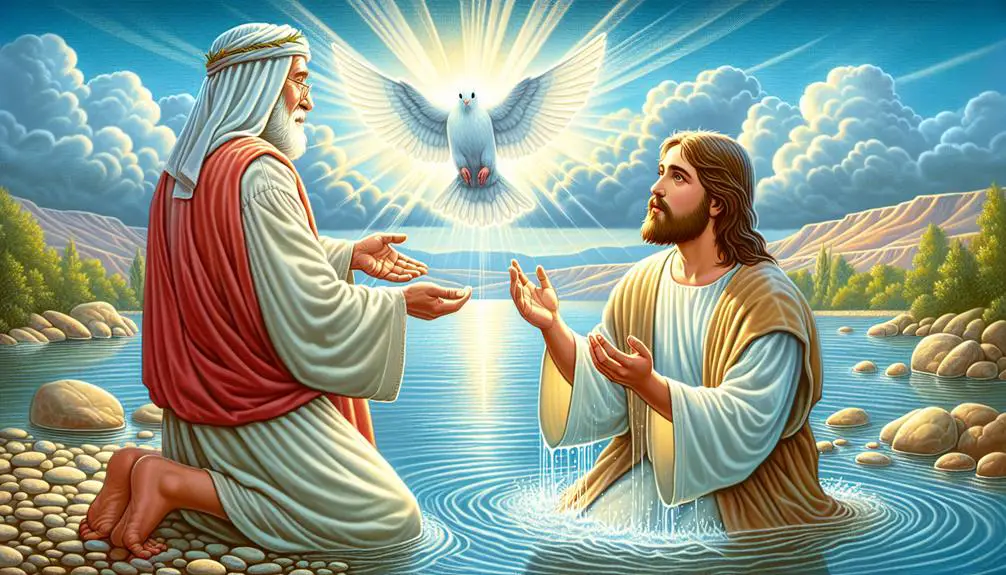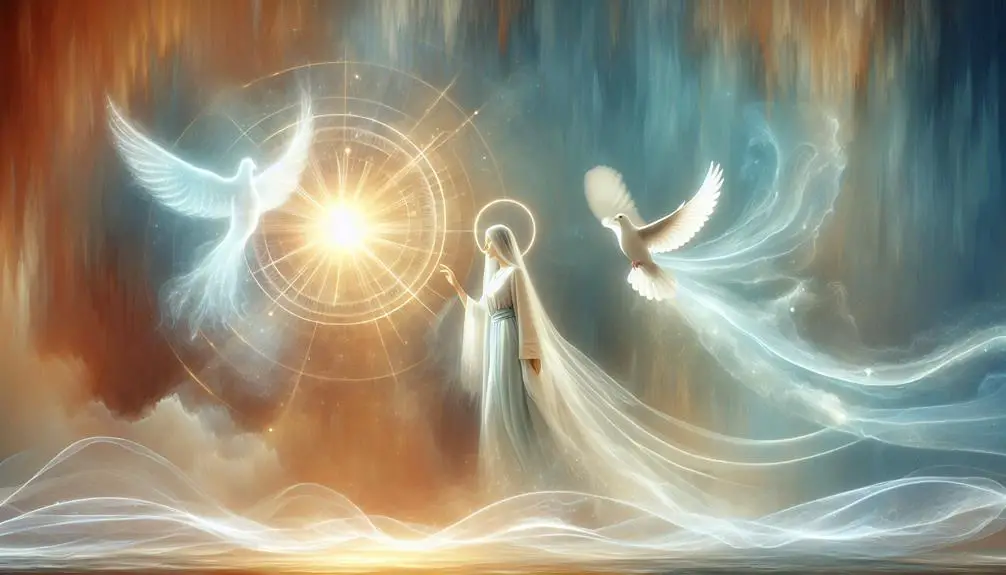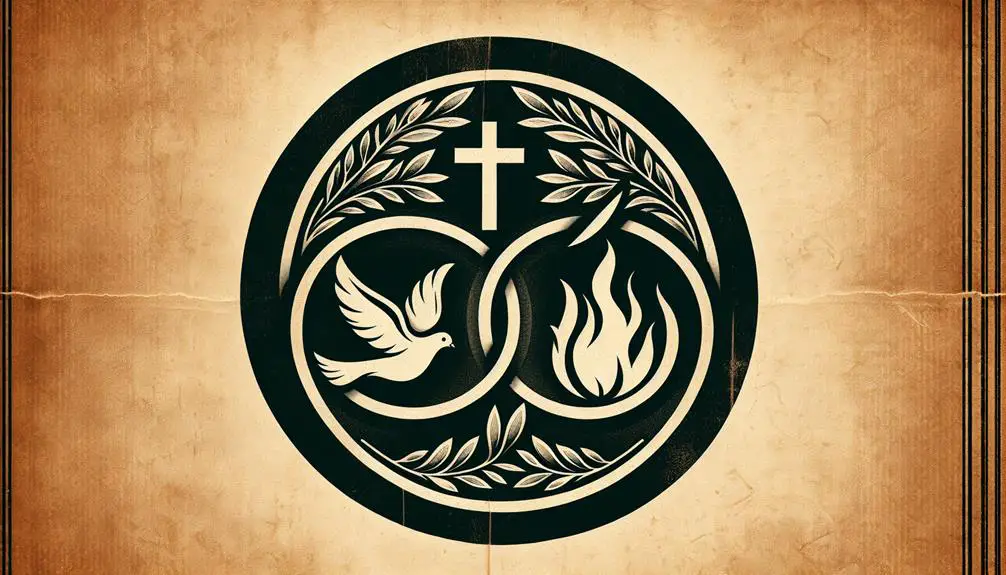Learn how the Bible subtly weaves the concept of the Trinity through its narrative, inviting deeper exploration into this divine mystery.

Evidence of the Trinity in the Bible
As they say, the devil is in the details, and when you're exploring the concept of the Trinity in the Bible, you'll find that truer than ever.
You've likely come across the Genesis creation narrative, the baptism of Jesus, or Christ's Great Commission and sensed something profound in those passages. These moments, alongside others like the Annunciation to Mary and the outpouring of the Holy Spirit at Pentecost, offer glimpses into the complex nature of God as understood by Christians.
But to fully appreciate the depth of this doctrine, you must look beyond the surface, where a rich tapestry of theological insight awaits your discovery.
Key Takeaways
- The Baptism of Jesus showcases the Trinity through the voice of God, Jesus' presence, and the Holy Spirit as a dove.
- Christ's Great Commission explicitly endorses the Trinity, instructing baptism in the name of the Father, Son, and Holy Spirit.
- Pentecost demonstrates the Holy Spirit's role, uniting believers and fulfilling Jesus' promise, thus evidencing the Trinity.
- Controversies like the Johannine Comma highlight historical debates on the Trinity but also underscore its foundational role in Christian doctrine.
The Genesis Creation Narrative

The Genesis Creation Narrative intricately lays the foundation for the theological concept of monotheism, asserting a singular divine entity's role in the creation of the universe. This narrative isn't just a simple story of how the world came to be; it's a complex exploration of divine intentionality and human purpose. Through the lens of garden symbolism and Adam's creation, you're invited to delve deeper into the layers of meaning that underpin this foundational text.
Garden symbolism, for instance, isn't merely a backdrop for the story of humanity's beginnings. It represents a divinely ordered space where harmony, fertility, and divine-human relationships flourish. The Garden of Eden, as described, is a space of perfect balance, meticulously crafted by God, highlighting the careful planning and purpose behind creation. This garden isn't just a physical location; it's a theological statement about the ideal state of existence, directly tied to the divine will.
Adam's creation, on the other hand, symbolizes the direct intervention of the divine in the material world. The act of forming Adam from the dust and breathing life into him illustrates a deeply personal and intimate connection between humanity and the divine. This moment isn't just about the beginning of human life; it's a profound statement about the nature of human existence, purpose, and the special role humans play in the divine order. Through Adam's creation, you're reminded of the unique relationship humanity has with the divine, marked by intimacy, stewardship, and responsibility.
Baptism of Jesus Christ

You'll find that the Baptism of Jesus Christ marks a pivotal moment in the New Testament, where the Trinity is symbolically represented.
As Jesus emerges from the water, a voice from Heaven declares Him as the beloved Son, and the Holy Spirit visibly descends upon Him like a dove.
This event encapsulates the distinct yet unified presence of the Father, Son, and Holy Spirit, inviting further examination of its implications for understanding the Trinity.
Heavenly Voices Emerge
During the baptism of Jesus Christ, a significant moment unfolds as heavenly voices are reportedly heard, marking a pivotal event in the theological understanding of the Trinity. These celestial symphonies and divine conversations create a profound moment of revelation and underscore the interconnectedness of the Father, Son, and Holy Spirit. Here's why this moment is crucial:
- Affirmation of Jesus' Divinity: It signifies God's public endorsement of Jesus as His Son.
- Introduction of the Trinity: The voices hint at a complex, divine relationship.
- Foundation for Christian Doctrine: This event lays groundwork for understanding the Trinity.
- Divine Communication: It exemplifies a rare instance where divine conversations are directly observed by humans, offering insight into the heavenly realm.
Spirit Descends Visibly
In the pivotal moment of Jesus Christ's baptism, a visible descent of the Spirit marks a significant theological event, illustrating the tangible manifestation of God's presence in the Trinity. The dove, symbolizing purity, peace, and the Holy Spirit, enhances the narrative's depth, linking divine intervention to a universally recognized emblem of grace.
Artistic interpretations over centuries have endeavored to capture this moment, each rendering contributing to the rich tapestry of theological discourse and understanding. These depictions not only embody the scriptural account but also invite reflection on the mystery and unity of the Trinity.
Through the lens of dove symbolism and artistic representations, you grasp a multifaceted perspective on this crucial event, underscoring its importance in Christian doctrine and its resonance across diverse cultures and epochs.
Christ's Great Commission

You'll find that Christ's Great Commission underscores the intricate relationship between the concept of the Trinity and the authority vested in Jesus Christ.
By instructing His followers to baptize 'in the name of the Father, and of the Son, and of the Holy Spirit,' He not only establishes the formula for the sacrament but also asserts His divine authority.
This directive serves as a foundational element for understanding the Trinitarian doctrine as it unfolds within Christian theology.
Baptizing in Three Names
Christ's Great Commission explicitly mandates the baptism of believers in the name of the Father, the Son, and the Holy Spirit, signifying a foundational aspect of Trinitarian doctrine. This directive not only underscores the unity and co-equality within the Trinity but also reflects the early Christians' understanding of the profound ritual significance of baptism.
Consider these aspects:
- Unity of the Godhead: Baptism in three names emphasizes the indivisible nature of God.
- Ritual Significance: It marks the believer's initiation into the Christian faith, symbolizing death to sin and rebirth in Christ.
- Early Christian Practice: This practice affirms the continuity of faith from the earliest followers.
- Identity Formation: It establishes a spiritual identity rooted in the Trinity, shaping the believer's faith journey.
Authority of Jesus Christ
Asserting his divine authority, Jesus commanded his followers to make disciples of all nations, baptizing them in the name of the Father, the Son, and the Holy Spirit. This mandate encapsulates the essence of Christ's authority within the Christian doctrine, intertwining it with the concept of the Trinity.
The authority of Jesus is further evidenced through his miraculous healings and the Transfiguration event, both of which underscore his divine nature and power. These acts not only affirmed his deity but also his role in the Godhead, reinforcing the Trinitarian belief.
Analyzing these events, one observes a coherent narrative of Jesus's authority, seamlessly linked to his divine mission and the foundational principles of the Trinity, illustrating a profound theological depth in the Christian faith.
The Annunciation to Mary

In the context of Christian theology, the Annunciation to Mary stands as a pivotal event wherein the angel Gabriel announces to the Virgin Mary her role in the divine plan of salvation. This moment encapsulates not only the divine initiative in the incarnation of Jesus Christ but also highlights Mary's obedience and the significance of angelic visitation in communicating God's will.
Here are four key aspects to appreciate about the Annunciation to Mary:
- Divine Communication: The angel Gabriel's visitation to Mary symbolizes the direct intervention of God in human history. This event underscores the belief in angels as messengers of God's will, bridging the divine and the human.
- Mary's Response: Mary's affirmative response, “Behold, the handmaid of the Lord; be it unto me according to thy word,” exemplifies her obedience and submission to God's plan. Her acceptance is crucial in the unfolding of the narrative of salvation.
- The Holy Spirit's Role: The Annunciation highlights the role of the Holy Spirit in the conception of Jesus, marking a significant moment of Trinitarian action visible in the scriptures. The Holy Spirit's overshadowing of Mary is an integral aspect of the incarnation.
- Fulfillment of Prophecy: This event fulfills Old Testament prophecies concerning the Messiah's birth from a virgin, linking the New Testament revelation back to the longstanding promises of God.
The Annunciation to Mary thus serves as a foundational event in Christian theology, illustrating the interplay between divine initiative, human obedience, and the fulfillment of biblical prophecy.
Pauline Epistles on Unity

Exploring the Pauline Epistles reveals a compelling emphasis on the concept of unity within the early Christian communities, a theme that resonates deeply with the foundational events of Christian theology such as the Annunciation to Mary. Paul's letters to the Corinthians, Ephesians, and Romans, among others, are replete with appeals for unity, underscoring its centrality in embodying the Christian faith and living out apostolic teachings.
You'll find that Paul doesn't just advocate for unity as a moral or ethical principle; he roots it in the very nature of the Church as the body of Christ. For Paul, unity isn't an abstract ideal but a lived reality, reflecting the triune nature of God Himself. He articulates this through his discussions on spiritual gifts, emphasizing that while the gifts are diverse, they're all manifestations of the same Spirit, intended for the common good.
Moreover, Paul's emphasis on unity goes beyond mere agreement or homogeneity. He challenges you to consider how unity in diversity reflects the complex, relational nature of God, as portrayed in the Trinity. Through apostolic teachings, he illustrates how spiritual gifts serve to unite the community, each member contributing to the whole, yet all working under the guidance of the same Spirit.
The Johannine Comma

Delving into the topic of the Johannine Comma, you'll find it represents one of the most debated passages concerning the doctrine of the Trinity in Christian scripture. This passage, found in 1 John 5:7-8, has been the center of much discussion in the realms of textual criticism and manuscript evidence. Scholars have scrutinized its authenticity and relevance to Trinitarian doctrine due to its late appearance in manuscript traditions and the implications it has for understanding early Christian beliefs about the nature of God.
When exploring the Johannine Comma, consider the following aspects:
- Textual Criticism: This discipline involves the examination and comparison of various biblical manuscripts to determine the most accurate text. In the case of the Johannine Comma, textual critics have noted its absence in the earliest Greek manuscripts and most ancient translations, suggesting it was a later addition.
- Manuscript Evidence: The earliest known Greek manuscripts that include the Johannine Comma date from the 14th to the 16th centuries. This late appearance raises questions about its originality in the New Testament text.
- Theological Implications: Despite its debated authenticity, the Johannine Comma has played a significant role in discussions about the Trinity, as it explicitly mentions the Father, the Word, and the Holy Ghost.
- Scholarly Consensus: While there's no unanimous agreement, a majority of biblical scholars lean towards viewing the Johannine Comma as a later interpolation rather than part of the original text of 1 John.
Understanding the Johannine Comma requires a deep dive into the complexities of textual criticism and manuscript evidence, highlighting the challenges scholars face in interpreting ancient texts.
Pentecost and the Holy Spirit

Shifting focus from the textual intricacies of the Johannine Comma, we now examine the event of Pentecost and its profound implications for the understanding of the Holy Spirit within Christian doctrine. Recorded in the Acts of the Apostles, this event marks a pivotal moment in the early church, showcasing the Holy Spirit's dynamic presence and power in a manner that hadn't been previously witnessed.
At Pentecost, you'll find that the disciples were gathered together when suddenly they experienced what's described as 'Tongues of Fire' resting on each of them. This manifestation of the Holy Spirit enabled them to speak in various languages, not previously known to them, allowing people from diverse backgrounds to understand the gospel in their native tongue. This phenomenon not only underscored the miraculous power of the Holy Spirit but also signified the unity of believers from different nations under one faith.
The event of Pentecost serves as a critical juncture in Christian theology, emphasizing the role of the Holy Spirit in guiding, empowering, and unifying the church. It demonstrates that the Holy Spirit is an integral component of the Godhead, working in harmony with the Father and the Son to accomplish the divine will.
Moreover, the descent of the Holy Spirit at Pentecost reinforces the concept of the Trinity, illustrating how the three distinct persons of the Godhead operate in unity and purpose. Through this event, believers are encouraged to recognize the Holy Spirit's active presence in their lives, fostering a deeper sense of unity within the global Christian community.
Frequently Asked Questions
How Do Early Church Fathers Outside of the New Testament Writings Interpret the Concept of the Trinity?
You're delving into how early church fathers, beyond the New Testament writings, interpreted the Trinity.
The Apostolic Fathers and the Cappadocian Contribution significantly shaped understanding. They didn't just accept a vague concept; they analytically engaged, providing a scholarly foundation for Trinitarian doctrine.
Their writings explore the intricate relationship between the Father, Son, and Holy Spirit, offering a deeper, more nuanced insight than initially apparent, objectively expanding on biblical interpretations.
Are There Any References or Allusions to the Trinity in the Old Testament Outside of the Genesis Creation Narrative?
Diving into the Old Testament, you'll find threads of a complex tapestry pointing towards the Trinity, beyond the Genesis narrative. Analyzing texts, you'll notice subtle references woven throughout.
Messiah prophecies and angelic appearances hint at a multifaceted deity, suggesting a plurality within God's nature. These elements, while not explicit, offer glimpses into the concept later fully revealed in the New Testament, underpinning the Trinity's foundation in ancient scripture.
How Has the Concept of the Trinity Influenced Christian Liturgy and Worship Practices Throughout History?
The concept of the Trinity has deeply influenced Christian liturgy and worship practices over time.
You'll notice Trinity symbolism woven into prayers, hymns, and rituals, reflecting its central role in theology.
The worship evolution, driven by this doctrine, has shaped how services are conducted, emphasizing the unity and distinction of Father, Son, and Holy Spirit.
This impact is seen across various denominations, highlighting its significance in shaping communal and individual expressions of faith.
What Are the Major Theological Debates and Controversies Surrounding the Trinity in the Early Christian Church, Especially Before the Nicene Creed?
You'll find the early Christian church embroiled in major theological debates, especially before the Nicene Creed's creation. The Arian Controversy and Modalistic Monarchianism marked monumental moments, molding much of the discourse.
Arians argued against Christ's divine equality with God, while Modalistic Monarchianism posited a singular God manifesting in different roles. These controversies carved deep divisions, driving doctrinal development and demanding detailed doctrinal definitions to defend the divinity doctrine rigorously.
Can the Concept of the Trinity Be Reconciled With the Strict Monotheism Found in Judaism and Islam, and How Do Other Abrahamic Faiths View This Christian Doctrine?
You're diving into whether the Trinity aligns with Judaic Shema and Islamic Tawhid. Both Judaism and Islam emphasize strict monotheism, challenging the Christian Trinity's compatibility.
Judaic Shema declares the Lord's unity, not allowing for a triune God. Similarly, Islamic Tawhid underscores Allah's singularity, contrasting with Christianity's three-in-one concept.
Other Abrahamic faiths view this Christian doctrine with skepticism, stressing the uncompromisable oneness of God in their beliefs.
Conclusion
Analyzing ancient texts reveals the Trinity's subtle signatures scattered throughout Scripture. From the Genesis genesis to Pentecost's powerful proclamation, each narrative nuance nudges towards a trinitarian theology.
Baptismal blessings, Christ's commissioning commands, and Pauline passages pivot around this profound principle. Even the enigmatic Johannine Comma contributes to the conversation, cementing a cohesive concept.
Thus, through theological threads and scriptural synthesis, the evidence of the Trinity in the Bible becomes both bountiful and believable, bridging beliefs with biblical bedrock.



Sign up